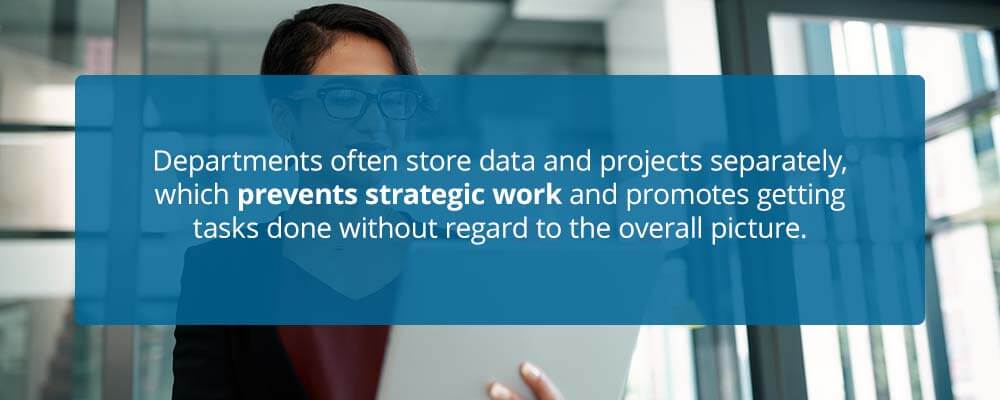Silos in government occur when agencies work independently and do not share information. In some cases, teams cannot share this information due to system limitations or security reasons. However, sometimes, separate departments do not collaborate even though nothing is preventing them from doing so.
This hierarchal organization maximizes vertical coordination by emphasizing collaboration and communication within the department or agency, but this comes at the expense of horizontal coordination. This expense is often literal, as agencies must work with limited or outdated information, causing operational inefficiencies. Eliminating silos in government helps agencies see the bigger picture and work for the common goal. Read on to learn how silos are overcome in a government setting.
In This Article
- What Causes Government Silos?
- 6 Reasons Silos Are Detrimental to Government Operations
- How to Eliminate Silos
- Create a Unified Vision
- Establish Shared Goals and Priorities
- Define What Collaboration Looks Like
- Open the Lines of Communication
- Get the Leadership Team to Support Open Communication
- Build Connections Between Your Silos
- Combine Project Tracking to Find and Fill Reporting Gaps
- Connect Activities to Outcomes
- Align Priorities Across the Organization
- Promote Bonds Across Teams
- Improve Government Plan Execution and Outcomes With AchieveIt
What Causes Government Silos?
Silos affect organizations of all sizes and types because they represent a mindset problem, not a structural one. The silo mentality is part of human nature. People want to work hard and stay focused on their areas of expertise. However, projects have better results with a collaborative push across departments instead of multiple individual efforts.
Silos persist in government because agency leaders allow them to. Managers may feel protective of their department’s information due to perceived competition or internal politics. When employees see their manager exhibiting this outlook, they will adopt it too. Silos often exist between competing departments with overlapping tasks. Employees can also have a silo mindset to protect their professional interests.
Here are the signs that your agency has government silos.
- There is a rivalry between your department and others: The rivalry mentality — or an “us-versus-them” mindset — focuses on your team getting the credit or the ability to outshine others. These turf battles create division in local government.
- Your employees play the blame game: When employees delegate their work to others and a problem arises, they can blame their co-workers since individual contributions to the project are ambiguous.
- Changes take a long time to implement: Silos prevent employees from understanding how changes will impact the work, so initiatives to change take longer to implement than necessary.
- Everyone agrees about everything: While being on the same page seems positive, this consensus may exist because the work environment discourages disagreements or employees don’t feel motivated to offer their input or suggest new ideas.
- Resources are hard to locate: Silos in local government may cause one team to conceal files, information, or equipment from others. When other departments need these assets, they’ll waste time hunting around.
- New initiatives are not common knowledge: When one silo creates a new initiative, it may be too late for another team to offer their input. This information could have been valuable in creating a better result.
6 Reasons Silos Are Detrimental to Government Operations
Lack of communication and poor collaboration are the two primary causes of failed projects in local government silos. Management for government projects requires people from different agencies or departments to collaborate to pursue a common goal.
There are many reasons silos can adversely impact government performance.
1. Focus on Minor Details Instead of the Big Picture
Employees can become so focused on their daily tasks that they lose sight of the bigger picture and their critical role in making it happen. For example, lowering the crime rate in your city involves the public safety department, human services agency, and education departments. Having these roles separated across uncommunicative agencies hinders success. If these departments do not cooperate, the objective will be harder to reach.
2. Weak Morale in the Team and Department

Government silos create a competitive atmosphere that hinders relations between teams and trust in the agency’s leadership. Employees may feel they cannot change this negative work atmosphere, which reduces their motivation. When morale is weak, it affects the project and the department as a whole.
3. Waste of Budget Funds
Silos prevent government agencies from maximizing their budget for the department. The problems created in government silos may cost money to resolve, which otherwise would have gone to a more vital need.
4. Duplicated Efforts Across Departments
With efforts spread across departments, it can be challenging for employees to know what others are doing. Multiple teams may end up working on the same thing due to miscommunication. Eliminating silos reduces these duplicated efforts.
5. Delays and Miscommunication
Many governmental efforts require input from various departments. If the project passes to the next department without communication, the team may be confused about their responsibilities. The concepts and decisions may not work for everyone, which may require the efforts put in the project so far to be worthless. This miscommunication causes delays that put the project behind schedule.
6. Lower Output and Productivity
Silos prevent employees from sharing their information, which means that some employees will not be aware of relevant details or must take time to locate them. Some employees may prevent others from accessing this information for personal or departmental reasons. The time spent locating or hiding information is time the team is not working on essential tasks, decreasing output and productivity.
How to Eliminate Silos
Eliminating or breaking down silos in government means establishing an effective way for the silos to communicate with each other and share information. As a result, the organization shifts from the “my department” mentality to an “our organization” mindset.
Leaders of successful governmental agencies understand that eliminating silos in government allows information to freely flow among departments, which leads to improved functions, efficiency, and projects. Enabling visibility across departments helps leadership manage projects and make more informed decisions to benefit the organization.
Here is how you can start cutting down on silos in government.
Create a Unified Vision

If each department has a different goal, or all departments have the same objective but interpret it differently, there is a lack of unity. When teams don’t have the same vision, they cannot connect and work together. Create a unified vision for all teams so everyone is working toward a shared purpose.
All employees should know:
- The department’s aims
- Why these goals are mission-critical
- The plan for achieving these objectives
- How each team will work to achieve that strategy
The leadership team needs to be the party that agrees to a unified vision, and they must fully understand it before passing it down to their teams. When the leadership team agrees, they’ll create empowerment for positive change and encourage trust in these new changes.
Establish Shared Goals and Priorities
Once you have established a unified vision with other leaders, you each must commit your team to collective success. The goal is to work for organizational success, not team success because, without silos, you can better focus on the big-picture ideas rather than your department’s objectives. When the teams are aware of how everyone is working toward these common goals, employees will be more willing to support each other.
Define What Collaboration Looks Like
Collaboration has different meanings to various employees. Identify what collaboration between teams will look like, including the behavior everyone should exhibit. When everyone understands what collaboration means and who is responsible for what, there will be no confusion, so everyone can start working.
Open the Lines of Communication
For collaboration to work, silos must be able to communicate freely. When everyone has access to recent and critical information, and anyone can talk to anyone else, knowledge spreads easily. These communication opportunities can be in a physical location at your facility, or you can opt for an online collaboration hub. Consider scheduling regular meetings between teams to discuss your collaborative opportunities and projects and their progress.
Get the Leadership Team to Support Open Communication
Leadership involves setting an example for team members by consistently modeling the desired behavior. Leaders need to be the first to break down silos in government and change their workflows to share resources and information with others. People who need direction will look to their leadership and mimic what they do. When leaders buy into open communication initiatives, they create a positive example. Employees will notice the difference and begin to think about the collective rather than the individual.
Build Connections Between Your Silos
In some cases, the silo mindset is an asset — for example, they help growing organizations focus and specialize in their area of expertise and manage one task or project at a time. When there is poor communication between different departments, the problem may be the management of the silos, not the fact that they exist. In some instances, the best solution may be to bridge them instead of dismantling them.
Combine Project Tracking to Find and Fill Reporting Gaps
In silos, reports and their results illustrate the progress within that department or agency. Without coordination across departments, you are unaware of the progress across your organization. Focus on a holistic analysis of how projects and plans are doing. Then, review the details of each project to see what is working, what is not, and why.
Connect Activities to Outcomes

Departments often store data and projects separately, which prevents strategic work and promotes getting tasks done without regard to the overall picture. If you do this, your department is missing valuable opportunities for collaboration. The goal should be to achieve the results the project was supposed to achieve, not complete the project quickly to get it off your to-do list.
Connecting activities to outcomes requires identifying the quantifiable outcomes and key performance indicators connected to your organization’s plans and projects. This information will give you something to measure against, so you can be aware of your progress. You can understand the context and impact of your efforts on company-wide outcomes instead of only knowing the project status.
Align Priorities Across the Organization
In addition to progress, silos often silo their priorities. This setup can mean that one employee has activities across different silos, or the managers are unaware of what other teams are working on. This lack of knowledge about your organization can mean that teams are working against each other or on the same initiative, which is also called duplicated efforts. Colliding or duplicating efforts wastes resources and time.
When all teams have the same priorities, they can be more focused and efficient. This cooperation can improve the work culture and make employees feel motivated and committed to the organization. Everyone will feel like they’re contributing to the bigger outcome.
Promote Bonds Across Teams
One way to break down silos in government is to create opportunities for members of various teams to get to know each other through collaborative exercises and team-building activities. Employees can see how other teams operate and understand their contribution to shared goals and priorities. Appreciating these roles will help employees freely share information when others need it and feel comfortable approaching other team members for input.
Here are some examples of cross-team exercises.
- Launch teams: Launch teams combine the most knowledgeable or talented members of each department. The launch team can work together on a critical task, and during the process, learn what other teams have to offer.
- Collaboration skill training: This training involves teaching employees collaboration skills — like open communication and active listening — and tasks that are not part of their job. This exposure to new abilities will help employees appreciate what other team members do and think about the information and resources they can offer to support their work.
- Team-building games: Team-building games are a way to break down silos by allowing employees to create new ideas and solve problems in a fun environment. The challenges will require employees to collaborate and brainstorm on the best way to win the game. An example of a team-building game is a scavenger hunt with a long list of hard-to-find items.
Improve Government Plan Execution and Outcomes With AchieveIt
Silos in government emphasize the individual over the collective, so there is minimal communication and collaboration between teams. Working independently instead of together can be detrimental to government operations by delaying projects, decreasing productivity, and costing money. Government settings overcome silos through intentional efforts to promote open communication. Having a unified vision, defining collaboration goals, and aligning priorities across your organization are some of the ways to eliminate silos in government.
AchieveIt helps federal government and state and local government organizations open their lines of communication to connect, manage, and execute plans and initiatives. Our collaboration platform gives team members oversight and visibility into these initiatives while establishing uniform data collection and promoting accountability. Several governmental organizations trust our FedRAMP-authorized platform, including NASA, the U.S. Air Force, and the Department of Veterans Affairs.
Schedule a software demo to see our platform in action, or contact us for more information.
Ready to improve your plan execution?
Organizations of all types leverage AchieveIt to manage, execute, and connect their most important initiatives. Replace manual processes & siloed systems with interconnected plans in a single, automated platform.



